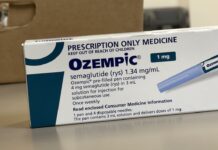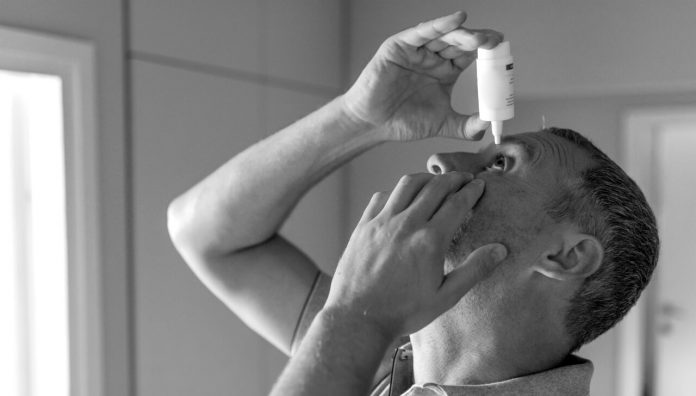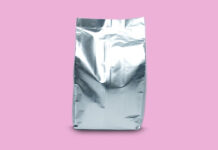Pharmacists play a referring role in supporting patients with dry eye.
Dry eye is a common problem, increasing in older age. Most cases are mild, and treatable with topical lubricants and minimising precipitants. However, without clinical investigation it may be difficult to identify the cause of an individual’s dry eye and to treat optimally, or to know whether there is another underlying condition. When a patient seeks advice, the pharmacist needs to know when to treat and when to refer.
What causes dry eye?
Dry eye disease, or keratoconjunctivitis sicca, occurs when the quantity and/or quality of tears fail to maintain adequate lubrication on the surface of the eyes. The cause is multifactorial, with an inflammatory component that can worsen the impact on the eye surface.1
The two main types of dry eye disease are aqueous deficiency and evaporative dry eye. Aqueous deficiency occurs with reduced aqueous production from the lacrimal glands. It accounts for 10% of the disease. Sjögren’s syndrome dry eye fits into this category.1
Evaporative dry eye is due to a deficient tear film lipid layer, increasing tear evaporation. It is caused by meibomian gland dysfunction, responsible for over 85% of dry eye disease. Rosacea (an inflammatory skin disease), blepharitis (an inflammatory eyelid disease), staphylococcus infection and seborrheic dermatitis can all disrupt the function of meibomian glands, leading to evaporative dry eye. A complicating factor of tear deficiency may be reduced resistance to infection, a cause and effect of blepharitis.1
Other conditions associated with dry eye are autoimmune disorders (e.g. Sjögren’s syndrome, lupus, scleroderma, rheumatoid arthritis), thyroid disorders, hepatitis C, vitamin A deficiency, facial nerve palsy, proptosis (abnormal protrusion of an eye), radiation therapy and chemical injuries.2,3
What are risk factors for dry eye?
Women are more likely to suffer from dry eye due to hormonal changes throughout life, and a greater likelihood of autoimmune disorders. It is more prevalent with advancing age because of less tear secretion. Medicines with anticholinergic effect (e.g. antihistamines, antihypertensives and antidepressants), are associated with dry eye.1-3 Decreased blinking (e.g. too much screen time, Parkinson’s disease), low humidity (e.g. air conditioning), and windy, smoky or dry environments can exacerbate dry eye.1 The condition is also worsened by contact lenses and refractive laser surgery.1,2
How is dry eye assessed?
The clinical presentation of dry eye varies considerably. Patients often describe non-specific symptoms such as visual disturbance, grittiness, burning or photophobia. Paradoxically patients can get excessive wateriness, as discomfort triggers reflex tearing. These symptoms may be present in other eye conditions such as ocular allergy, corneal erosion or a foreign body. Therefore, clinical assessment is required to diagnose dry eye disease.1 Jason Holland, National Director of Optometry for the OPTICAL Superstore, advises that an accurate diagnosis by an optometrist would result in the right advice, and a return to the pharmacy for appropriate treatment. See Box 1 for red flags needing prompt referral.4
BOX 1. NICE guidelines for referral to an optometrist or ophthalmologist
|
Reference: Findlay et al6
How to manage dry eye?
Treatment of dry eye aims to relieve symptoms and prevent eye surface damage. For first-line management of mild disease:1
- Apply ocular lubricants. Drops, gels or ointment could be used depending on the severity. The preservative-free product is preferred.
- Preservatives can exacerbate inflammation in dry eye. Benzalkonium chloride is more irritant than others.2,3
- Holland advises ocular allergy can result in similar symptoms and needs an alternative treatment strategy rather than a topical lubricant.4
- Consider adding a lipid layer stabiliser. Holland says ‘a topical lipid preparation may be appropriate treatment for many patients, as the majority suffer from meibomian gland dysfunction, which causes a defect in the tear lipid layer. Topical aqueous lubricants can be insufficient for many patients unless they also suffer from an aqueous deficiency’.4
- Treat blepharitis with lid wipes, rosacea management and infection eradication, e.g. a week of chloramphenicol ointment to lid margins.
- Optimise Meibomian gland function with warm compresses or warming eye masks.
- Make environmental changes to decrease tear evaporation – avoid wind, smoke and dust. Use a humidifier, reduce computer use and break for eye rest with ‘conscious blinking’.
- Review exacerbating medicines e.g. antihistamines, beta blockers, tricyclic antidepressants, selective serotonin reuptake inhibitors, isotretinoin.
A patient with dry eye requires ongoing vigilance to minimise effect on their quality of life.
Role of the pharmacist
Pharmacists are well placed to support patients with dry eye and offer management advice. Assess the patient and ask for a description of symptoms, severity and duration. Be alert for alternative symptoms of hay fever (itchiness) or conjunctivitis (watery discharge). Ask about other medical conditions. Severe or persistent symptoms should be referred. For Box 1 symptoms, refer on the same day to an optometrist or GP for referral to an ophthalmologist. Collaborate with these health professionals. After diagnosis from an optometrist or ophthalmologist, advise patients on appropriate preparations. Monitor ongoing use and refer back to either specialist when needed.
Refer to resources such as PSA’s Professional Practice Standards: 4 (Provision of Non-Prescription Medicines), 9 (Collaborative Care) and 13 (Disease State Management).5
Key points
- Dry eye is a common condition that can significantly impair quality of life; most patients have mild disease.
- Management of mild disease involves minimising precipitants, treating with topical lubricants, and using techniques to manage Meibomian gland dysfunction.
- Patients with more severe symptoms should be referred to an optometrist or ophthalmologist for assessment.
- Pharmacists can support patients with dry eye and refer when indicated.
References
- Findlay Q, Reid K. Dry eye disease: when to treat and when to refer. Aust Prescr 2018;41:160–63. At: https://www.nps.org.au/australian-prescriber/articles/dry-eye-disease-when-to-treat-and-when-to-refer
- Facts about dry eye. The National Eye Institute; 2017. At: https://nei.nih.gov/health/dryeye/dryeye
- AMH Aged Care Companion (online). Adelaide. Australian Medicines Handbook; 2019. At: https://shop.amh.net.au
- Interview with Jason Holland, National Director of Optometry for the Optical Superstore, on 23/07/2019.
- Pharmaceutical Society of Australia. Professional Practice Standards. Version 5. Canberra: PSA; 2017. At: https://www.psa.org.au/wp-content/uploads/2018/08/Professional-Practice-Standards-v5.pdf
- Findlay Q, Reid K. Dry eye disease: when to treat and when to refer. Aust Prescr 2018;41:160–3. At: https://www.nps.org.au/australian-prescriber/articles/dry-eye-disease-when-to-treat-and-when-to-refer



 Now a PhD candidate, former Sudanese refugee and NSW Pharmacist of the Year
Now a PhD candidate, former Sudanese refugee and NSW Pharmacist of the Year  David North OAM
David North OAM NSW Early Career Pharmacist of the Year Lily Pham
NSW Early Career Pharmacist of the Year Lily Pham



 Professor Stephen Nicholls[/caption]
Professor Stephen Nicholls[/caption]








